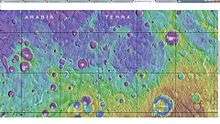Pasteur (Martian crater)
| Planet | Mars |
|---|---|
| Coordinates | 19°24′N 335°30′W / 19.4°N 335.5°WCoordinates: 19°24′N 335°30′W / 19.4°N 335.5°W |
| Diameter | 113 km |
| Eponym | Louis Pasteur |
Pasteur Crater is a crater in the Arabia quadrangle of Mars, located at 19.4° north latitude and 335.5° west longitude. It is 113 kilometres (70 mi) in diameter and was named after Louis Pasteur, a French chemist.[1]
Dark sand dunes are clustered in the southwest of the crater. The orientation of the barchan dunes suggest that they were generated by northeasterly winds. The source of the dune's sand appears to be local. Upwind of the dunes there is a small crater, Euphrates, within Pasteur crater that may have excavated sediments. The dark sediments have formed a patch at Euphrates' base. HiRISE imagery of the intracrater dunes within Pasteur crater over 1 martian year indicate that the dunes are active with sand movement in a southwesterly direction.[2]
 MOLA map, showing Pasteur crater and other nearby craters. Colors indicate elevations.
MOLA map, showing Pasteur crater and other nearby craters. Colors indicate elevations.- Map of Arabia quadrangle with major craters.
- Pasteur crater floor, as seen by HiRISE.
References
- ↑ "Gazetteer of Planetary Nomenclature | Pasteur". usgs.gov. International Astronomical Union. Retrieved 4 March 2015.
- ↑ Geissler, P. E.; Stantzos, N. W.; Bridges, N. T.; Hirise Science Team (March 2011). "Shifting Sands on Mars: 3 Case Studies" (PDF). 42nd Lunar and Planetary Science Conference. Lunar and Planetary Institute.